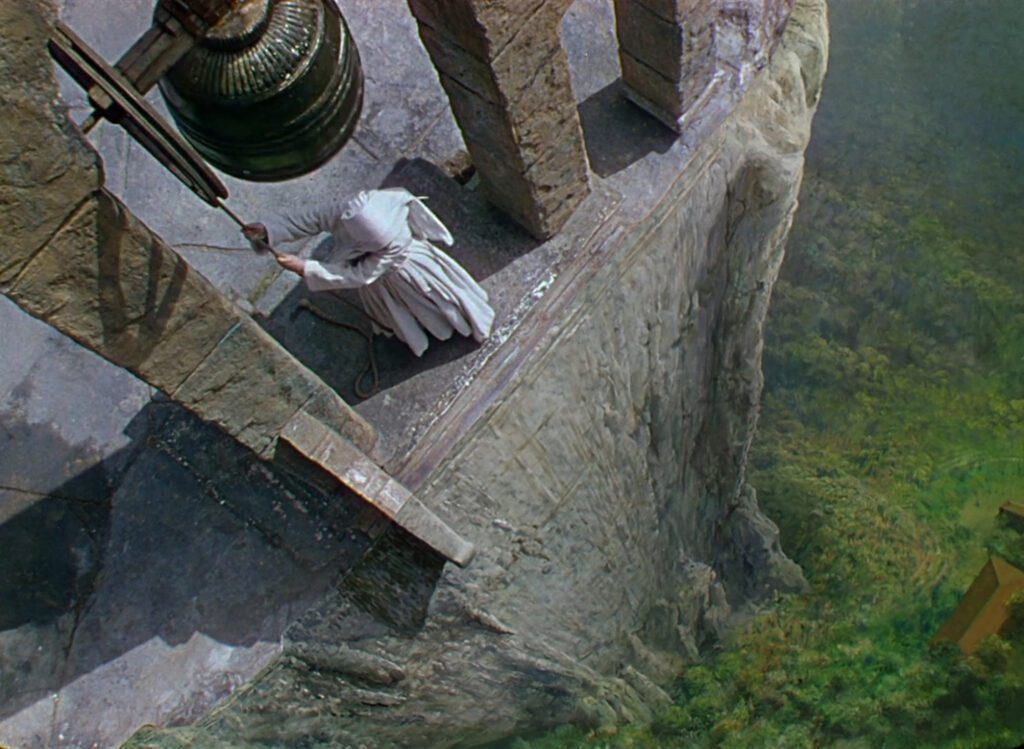
Black Narcissus
1947, directed by Michael Powell & Emeric Pressburger
Black Narcissus is a story of failure. That’s nothing too unusual, but the failures here are nuns, led by the sympathetic and virtuous Sister Clodagh, the kind of movie character who usually triumphs over adversity. How many films about doomed exploits end with the strange exhilaration that accompanies the sisters’ exit from Mopu Palace? Black Narcissus does not play by the usual rules.
From the nuns’ perspective, things get worse and worse. Sister Ruth leaves the order, gets rejected by Mr. Dean, tries to push Sister Clodagh off the cliff, and plummets to her death in the struggle. Sister Philippa loses focus and plants flowers where the vegetables should go, leaving the convent short on food. Sister Blanche (a.k.a. Sister Honey) unwisely gives castor oil to a sick baby, bringing blame on the nuns when the baby dies, so that nobody comes to their school or hospital anymore. Sister Clodagh gets distracted by memories of a past heartbreak. Only Sister Briony keeps her head, but it’s no use… the nuns cannot possibly carry on their mission.
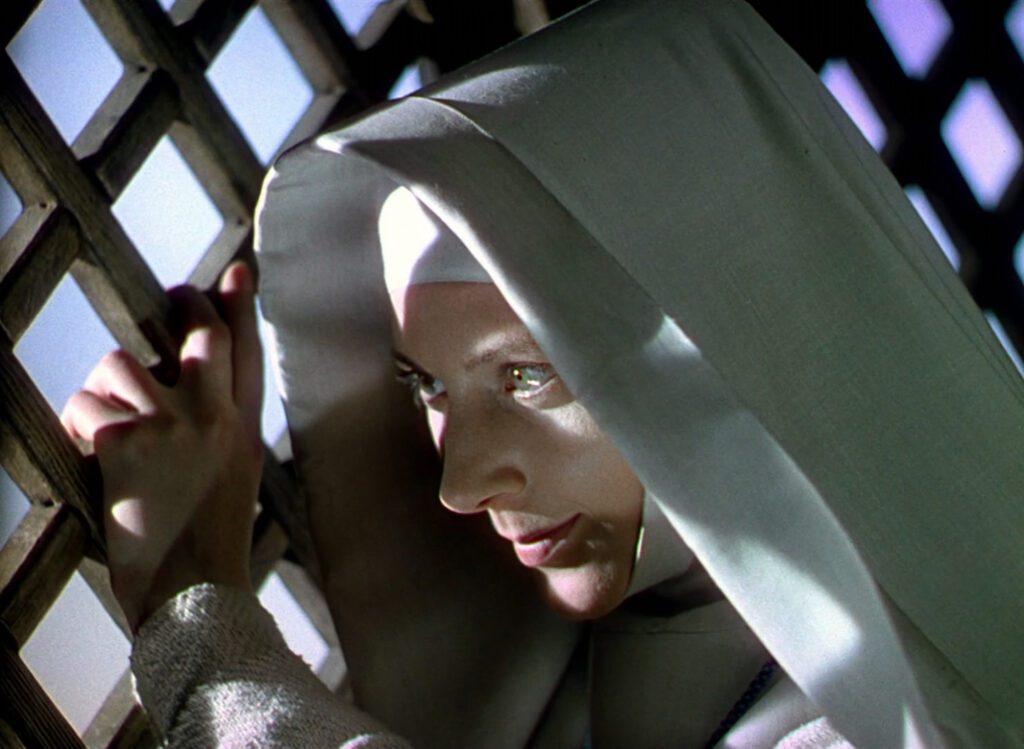
Failure, however, depends on the point of view. The natives may be deprived of the sisters’ medicine and education, but they’re left to live on their own terms as they always had. Most of them weren’t happy with the nuns anyway. The general had to pay them to visit the mission. The caretaker Ayah dislikes the nuns, and Joseph Anthony bristles under their condescension. Mr. Dean understands the natives better, and in spite of his fondness for Sister Clodagh, he encourages the nuns to leave.
Black Narcissus was released in April 1947, about four months before India achieved its independence from the British Empire. The independence movement was coming to a head, and the outcome was already known. The movie comes from a novel written in 1939, but the story must have found new relevance on the eve of Britain’s withdrawal from India. Like the British Raj, the nuns do not belong where they are, and they are ultimately compelled to leave. Black Narcissus hoped to reconcile the British people to the inevitable demise of colonialism.
Like so many colonial powers, the nuns arrive at the behest of a local potentate, justifying their presence with a mission to bring education and medical care. There are also hints of religious proselytization. Treating the natives as children, they attempt to instill discipline, imposing their particular work ethic on people who were already hard working. On the surface Sister Clodagh seems just and reasonable, but when she measures the convent’s property she objects to the holy man’s presence, even though he had been there first. Her behavior reflects the typical intrusiveness of European colonizers obsessed with boundaries and legalities.
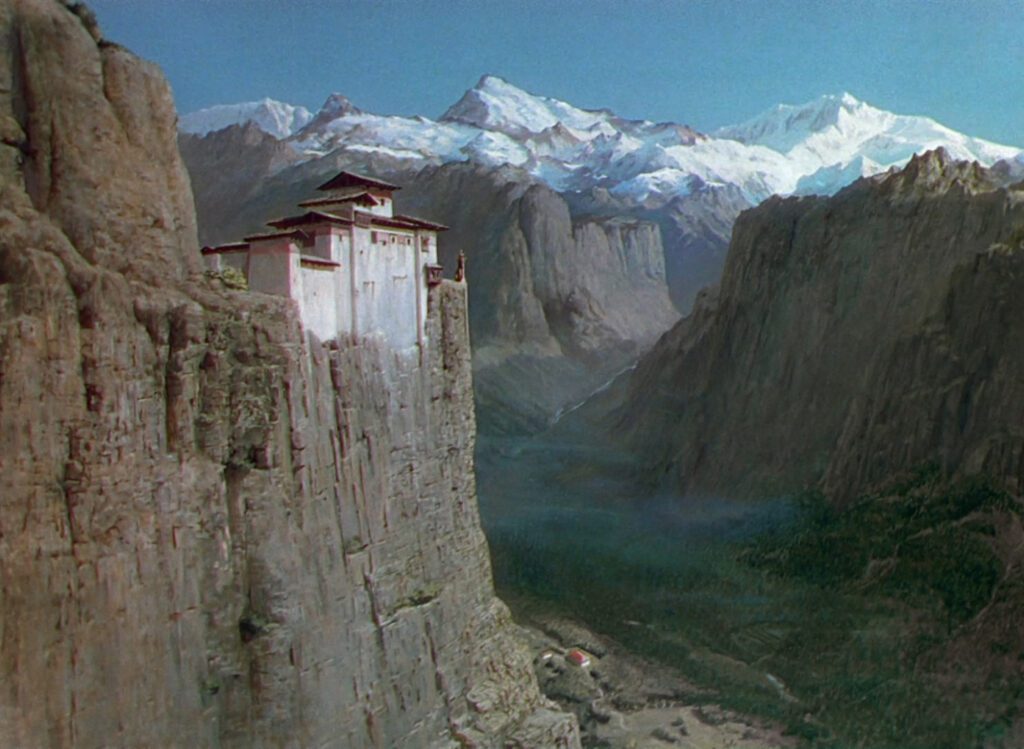
The convent at Mopu Palace is perched on a precipice high above the valley where the locals reside, and matte shots accentuate the vertical distance. Its lofty separation is a correlative for the assumed superiority of the British nuns, who place themselves above the people they purportedly came to serve (the film makes a big deal of the word “superior”). The cold Himalayan winds blowing through the convent are a metaphor for the coldness of colonial authority. Under the old general’s father the palace had been a harem, and Sister Clodagh orders the paintings of nude women removed from sight. In another context the repurposed “pleasure palace” would imply a reversal of patriarchy, but here it suggests an imposition of foreign sexual norms.
Each of the five nuns illustrates a particular facet of colonial attitudes. Sister Ruth has contempt for the natives and treats her students harshly. Sister Honey is compassionate but counterproductive in her charity. Sister Philippa aestheticizes the occupied country, turning it into her private paradise at the expense of people’s needs. Sister Briony is an obedient official doing what she’s told. Sister Clodagh is the strong-willed but ineffective governor, full of good intentions but bringing more harm than benefits. Dean fits in better because he’s not a colonizer but an employee of the native ruler. The movie itself, with its lush Technicolor and jaw-dropping dioramas, might be accused of exoticizing India, but its point is not to hide or deny the life or culture there – rather it imputes to India a strange power to bend the wills of those who occupy it.
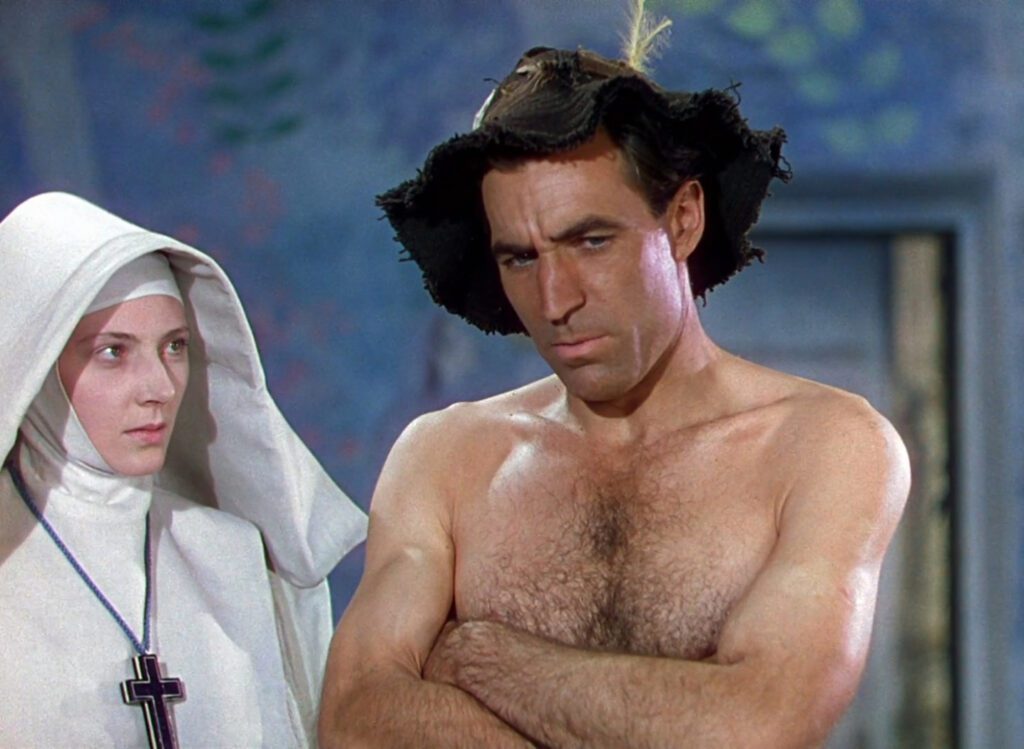
The nuns might stand above their subjects, but one silent character sits above them – the holy man, whose ledge is higher than the palace, and who unnerves Sister Clodagh. His presence insinuates that even during the Raj there was a spirit of India that stood above the country’s occupiers, watching and understanding everything. Mr. Dean catches Sister Clodagh short when he tells her that the old man reportedly speaks fluent English and several other European languages.
Although British audiences should have recognized, at least unconsciously, their relationship to India in the nuns, the fact that they are Roman Catholic – and that Sister Clodagh is Irish – puts them at a safe remove from Great Britain. The point of Black Narcissus is not to point fingers at the British but rather to soften their sense of loss as their colonies begin to slip away. In one understated detail, however, Clodagh mirrors English history. Many years ago her financially ambitious lover had left her for America, and her memory of him is a subtle reminder of another big colony the British Empire had lost long ago.
The purpose of Black Narcissus was not to change minds on some controversial political topic, but rather to turn people’s points of view, in a small but consequential way, toward acceptance of the inevitable. Given that it’s about the way people can look at a situation, it’s surely not irrelevant that it’s bracketed by people staring into the distance. Immediately after the opening titles, the Mother Superior in Calcutta stares through a sunlit window, and the movie ends with two people staring far away. Sister Clodagh looks up first at Mopu Palace until a cloud obscures it, whereupon she turns to look ahead at her next destiny. Finally Mr. Dean turns dramatically to watch the nuns riding off into the monsoon rain until they too are obscured.
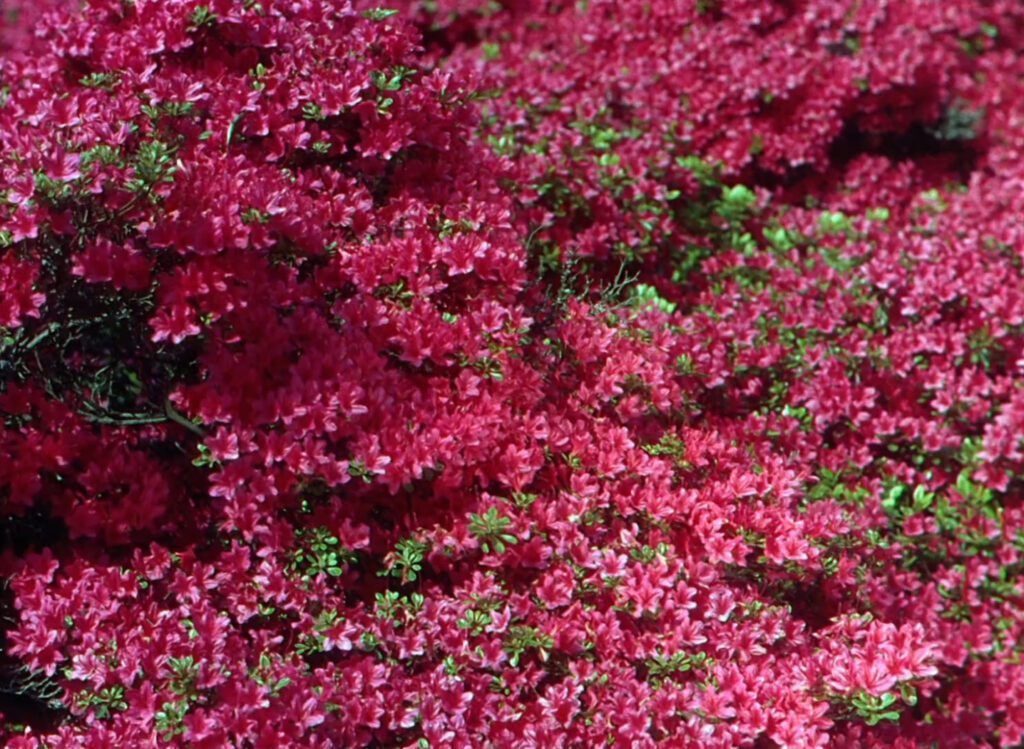
Both the palace and the caravan thus fade into invisibilty, shrouded in mist, and if we’ve watched attentively we might notice how much else in Black Narcissus is invisible. Religion is all about the invisible, as the convent’s name Saint Faith emphasizes so pointedly. The film’s title is the name of a perfume, which is invisible when it’s being used. Sister Clodagh’s first line is a fragment of an algebra problem, “…therefore x is equal to five,” whose variable is likewise invisible. So too are the malign workings of pathogens and the benign workings of medicines, which play key parts in the nuns’ mission, and also the mysterious workings of the deity that Clodagh credits for her vocation. Most of all it’s the air everywhere that makes the presence of the invisible so keenly felt. It blows through the long horns in the opening shot and circulates from the ceiling fans in Calcutta. The winds are omnipresent at Mopu, and the characters often speak of the clear mountain air.
So much is tangibly invisible that Black Narcissus doesn’t need ghosts to feel haunted. It’s not that invisibility dominates the film; rather there’s a kind of dialectic between the visible and the invisible. Whatever is given to the eyes is given in abundance. Everywhere there are bold colors and striking vistas. The editing springs one visual shock after another: the cross-shaped dining table in Calcutta; the chasm below the palace; the magenta blossoms in the valley; the palace’s blue-walled salon; the reds of Sister Ruth’s hair, lipstick, and eyes, or the bloodstains on her gown. The painted nudes in the palace would have been shocking in a nunnery, and so too would Mr. Dean when he entered the convent bare-chested.
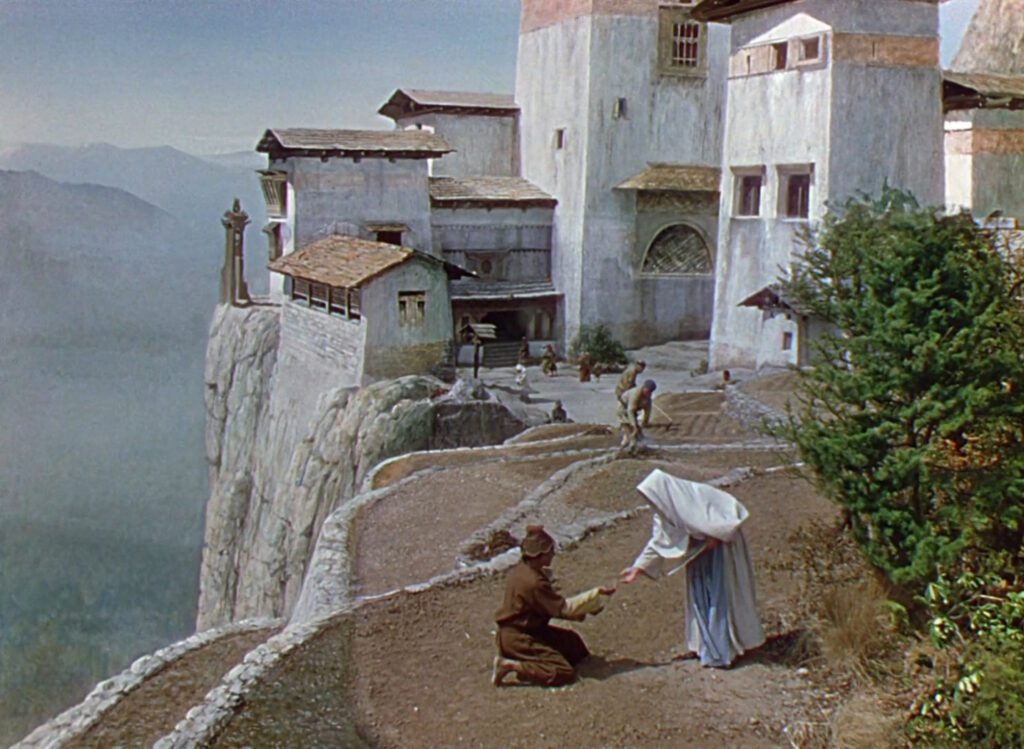
Between this visual overload and all the suggestions of invisibility there’s a paradoxical balance between the corporeal and the spiritual that’s also reflected in the title. A perfume is invisible and sensual at the same time, and the name “Black Narcissus” blends the earthly and the heavenly, just as Narcissus was descended from both a god and a nymph. The coexistence of the spiritual and sensuous is an apt characterization of India, but it also speaks of the incompleteness in any single point of view. The poetic image of “Black Narcissus” may sound exotic to the British, but the Young General says the perfume comes from the army-navy stores in London. The exoticism that the British attributed to India was in fact a projection of their own culture and their own desires. However much India presented itself to their senses, much of the country was still invisible to them.
CONNECTIONS:
I Walked with a Zombie – Attempt to change attitudes on the home front through gentle persuasion
A Matter of Life and Death – Gentle push for peaceful adjustment to a new post-war world order
The Battle of Algiers – Story of a colonized nation’s independence and the errors of colonialism
India Song – European vision of India filmed entirely in Europe
Antareen – Characterization of Britain’s colonization of India